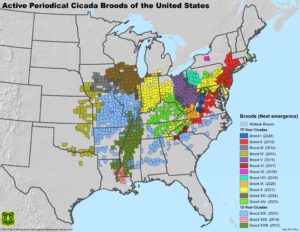Within a few weeks cicadas will inundate readers living in eastern Ohio and West Virginia as well as adjacent parts of Pennsylvania, Maryland, Virginia, and oddly enough Suffolk county on Long Island. After spending seventeen years sucking nutrients from tree roots billions of cicada nymphs will emerge from the ground. The nymphs quickly climb off the ground, shed their outer skins, sprout wings, and set to work on creating the next generation of cicadas.
For a little more than a month their buzzing chorus will fill the air. It will be nearly impossible to walk anywhere without stepping on the desiccated husks of their molted nymph skins. When I was a young child we collected the husks and used them as space monsters. Toward the end of their life cycle their dead bodies will litter the ground like leaves in the November. As a lifeguard we used to fill a five gallon bucket with dead and dying cicadas every morning when we cleaned out our skimmers. Roughly six weeks after the first nymph emerges everything ends. The last adults die and their cacophonous chorus goes silent.
While cicadas are found all over the world, the eastern US is the only place with true periodical cicadas – those that emerge as a single brood on a set schedule. Entomologist C. L. Marlatt established the brood numbering system. Numbers I-XVII represent the possible seventeen year broods and XVIII-XXX represent the thirteen year broods. While that yields a possible thirty broods, only seventeen have actually been observed. Two of those (XI and XXI) have missed more than one cycle and are presumed to now be extinct.
A few interesting periodical cicada facts:
- There are twelve different broods of 17-year cicadas and three broods of 13-year cicadas
- Cicadas only feed on the roots of deciduous trees
- Broods emerge when the soil temperature 8″ below the surface reaches 64F (18C)
- Their large numbers overwhelm predators because it’s simply impossible to eat them all
- The fact that their long breeding cycles are also prime numbers makes it hard for predators to synchronize their own population cycles to those of the cicada
- Their eyes can be orange, red, yellow, or blue, but are never green
- People who eat cicadas insist they taste like popcorn or potato chips
- Tree growth declines the year before a brood emerges because the larger nymphs need more food
- While most predator populations get a boost the year a brood emerges, mole populations peak a year earlier
- Intermingling between 13-year & 17-year broods that overlap occurred in 1998 and won’t happen again until 2219.
For more information and facts about cicadas please visit cicadamania.com
Today’s Map
Courtesy of the USDA Forest Service this map illustrates the locations for each of the active periodical cicada broods.
As always thanks for reading.
Armen
As an aside please consider signing up for my FREE author newsletter. It will contain opportunities to preview new books, announcements, and contests related to my novels. It will not overwhelm your inbox – I’m thinking once a month or less depending on news.
If you have subscribed, but haven’t received a newsletter, please check your spam folder. Moving the newsletter to your inbox should fix the issue.



Reminds me of once when I was out hunting. I was at the edge of a large meadow and heard a droning sound that was getting louder. Turned around to see a cloud of locusts coming straight at me about six feet off the ground. I dove into the high grass at the edge of the meadow and watched them fly right over my head. Scary thought. . .